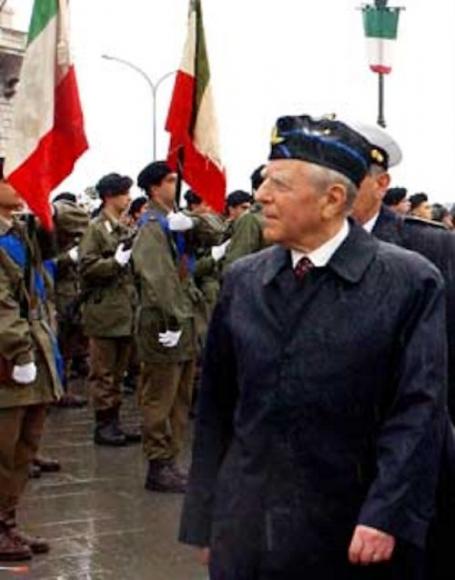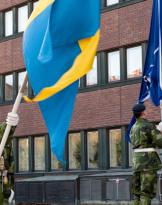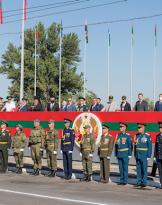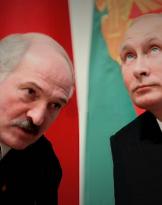The umbrella, which has always been banned in the military, is now prescribed by a special circular1, which regulates its use according to the situation and the uniform worn. Is this perhaps a sign of bourgeoisie in the exterior of the military form? Immediately on social media there were jokes and joking cartoons, such as: attacker in the hole while shooting asks for "cover me" and immediately the couple comes with an open umbrella. Therefore, this novelty can be interpreted, also in the light of the "military spirit"2, and to proceed in this direction we will draw on the paradigm of the military organizational culture3.
The umbrella is an object of current practicality - as long as the bora does not blow, which would make it unusable - and very suitable for sheltering from the rain (even from the sun). In its various possible shapes, it can also become a refined accessory for elegant men and women. In the City of London it once distinguished gentlemen, but not only; elsewhere the ladies could wear it embellished with a silver handle. Today colored fabrics are preferred and technology allows the creation of pocket-sized, telescopic models. The higher quality models carry a brass plate with the manufacturer's logo on the handle.
Being an item of kit that necessarily requires the use of one hand, it is not very suitable forhomo faber, who always have both hands free, ready for action. In this perspective, it could have called itself a bourgeois object, before the definition of "middle class" had supplanted that particular representation of a certain social status.
The Army circular now foresees two types, pocket-sized, that is foldable and ordinary, but strictly black, without ornaments and much less ... badges, brands and various personalizations, at least for now; finally to be carried with the left hand to allow the right to salute the visor.
In the context of corporate cultures, with which psychologists investigate organizations to improve their functioning, the umbrella will fall into the category of "artifacts". This category brings together the products artfully created and adopted to perform certain functions, but which must also be considered for what they express (non-verbal, symbolic communication) of the other two categories of content, typical of organizations: "tacit and shared assumptions" and "values"4. Wanting to deepen, we would see that assumptions and values are components of the "Vision" and "Mission" of the corporate establishment. And that artifacts invariably express these two categories.
To get into the nature of the umbrella now adopted by the Army, from the point of view of military organizational culture, I will begin by recalling a personal memory. On the morning of May 4, 2002 we were in Trieste, in Piazza dell'Unità d'Italia, awaiting the arrival of the President of the Republic, Carlo Azeglio Ciampi, for his speech at the ceremony celebrating the 141st anniversary of the constitution of the Italian army. It was raining in very intense downpours (the bora did not blow) and the soldiers wore raincoats. The ceremony could not foresee a configuration for the rainy weather and the ceremonial officers were confronted by looking for a possible solution that would avoid the rain for the president.
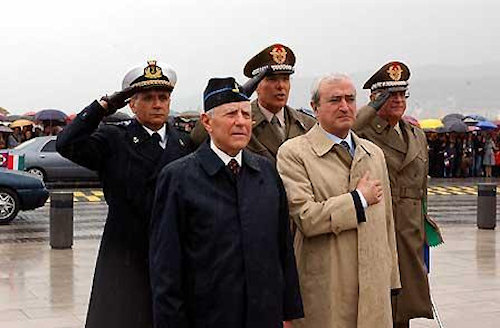 There was no mention of an umbrella because, as is well known, it would not have been appropriate with the departments deployed. Nor could the review group have used it since it is also made up of military personnel. Ciampi himself, unexpectedly, resolved the protocol question, who, as soon as he arrived, took his driver's bag out of his pocket and wore it with that military style that brought him so close to the armed forces and combat and weapon associations. This gesture could not fail to produce a thrill of emotion and passion in those present.
There was no mention of an umbrella because, as is well known, it would not have been appropriate with the departments deployed. Nor could the review group have used it since it is also made up of military personnel. Ciampi himself, unexpectedly, resolved the protocol question, who, as soon as he arrived, took his driver's bag out of his pocket and wore it with that military style that brought him so close to the armed forces and combat and weapon associations. This gesture could not fail to produce a thrill of emotion and passion in those present.
The sachet, the military headgear in general, is another artifact that well expresses the military organizational culture. Color is significant of the armed force; the weapon badge indicates its belonging; then it shows the degree; other elements of embellishment always carry a meaning. For example, the chin strap tells us that that headgear would have been worn in battle, on horseback, under bad weather, or in those critical situations, but characterizing the military condition.
The course of the demonstration had a variant that was then benevolently criticized by many: to avoid the inconvenience of the rain for the military deployed, all speeches were omitted and comments were more or less of the type: "Why worry about the rain if we are military?" President Ciampi never adopted an umbrella in the presence of military personnel.
Today, with the changing paradigm, this would be possible. But from the point of view of military organizational culture, what has changed? The question is also pertinent because, up to the moment of its adoption, the umbrella was banned and who knows whether some fearless undisciplined person was also recently the subject of disciplinary sanctions for using it, despite the regulation in force at the time.
The tacit and shared assumptions of military culture are qualities well rooted in the military condition which, although widely felt by all those who bear them, do not find determination in the written regulations and rules. Anyone wishing to fully understand what it is could read Tolstoy's tales of the Crimean war, of the defense of Sevastopol. In those stories the soldiers talk about themselves by bringing out vices and virtues, for example courage in battle, or that an officer must in all circumstances show himself to the troop fearless, superior to the danger of losing his life. Most of those assumptions are still present in today's military organizational culture.
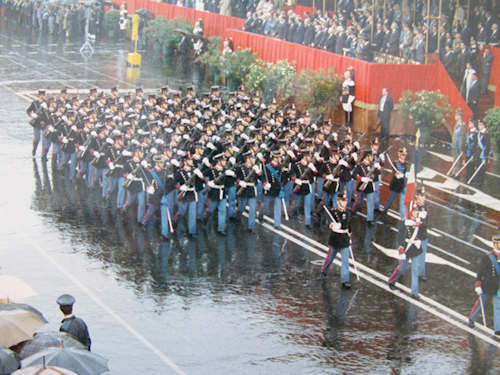 To make explicit the concept of artifact of military organizational culture, elsewhere, I have referred to the phenomenon of military music. A military march, performed by the gang, is an artifact. It expresses the military spirit. The score, through musical notation, is instead a written document, therefore it belongs to the category of values.
To make explicit the concept of artifact of military organizational culture, elsewhere, I have referred to the phenomenon of military music. A military march, performed by the gang, is an artifact. It expresses the military spirit. The score, through musical notation, is instead a written document, therefore it belongs to the category of values.
Returning to the military umbrella, the tacit and shared assumption that could conflict with its adoption is that a soldier should not worry about getting wet because he is used to facing bad weather and inconvenience. He wears protective clothing, of course, also waterproof, but reserves the right to keep his hands free to act as is appropriate if necessary. This mentality would be well established depending on the life experience that the soldier has, both in training and in the course of operations. This fact is incontrovertible and, in fact, the law just issued specifies very well that the umbrella can only be adopted in a context para-civil, not with the uniform of service and combat, so to speak, that is, when you work in the city, at the territorial commands and to go from home to work and vice versa; once upon a time it would have been said: for pleasure. A para-civil context that would show a very peculiar condition of the work that a soldier can be called upon to carry out. Situation that makes this accessory-artifact practicable.
The summary is that the adoption of the umbrella, in itself, will not change the essence of the military condition. Certainly, it remains important that the military organizational culture remains with its peculiarities and is not contaminated by forms of bourgeoisie of greater substance, such as to generate sub-cultures deviating from the main paradigm. Because it is a culture very rich in values: from the Constitution with its articles that refer to war and the defense of the homeland, to the various rules, regulations and declinations in terms of strategy, operational art, tactics and technical procedures; as well as tacit and shared assumptions, which must circulate, thought and said even if not written, among those who are the natural supporters, the military, animating their action even in situations peculiar to the military condition, so different from those practiced in the civil life. In fact, with the Military Organizational Culture the "military spirit" of Clausewitz's definition, which one, is called into question essential condition of the operational efficiency of an army.
1 Circular subject "Use of the umbrella by Army soldiers in uniform." Prot. SME M_D AE1C1B2 REG 2022 0275445 24-08-2022. (Office of the Deputy Chief)
2 The definition of military spirit is found in Clausewitz, Della Guerra, book III, chapter IV "Predominant moral forces"
3 Same author. Military Organizational Culture. Army Study Center (2021). Available at: https://www.centrostudiesercito.it/cultura-organizzativa-militare.html
4 Edgar's theorizing is at stake here. H. Schein.
Photo: historical archive of the Presidency of the Republic / author

